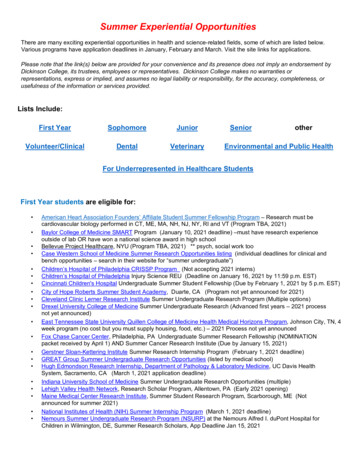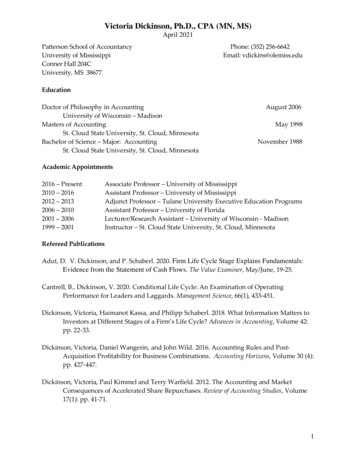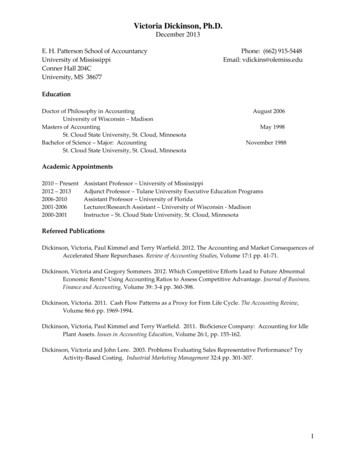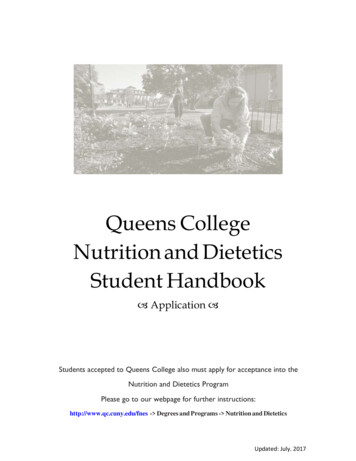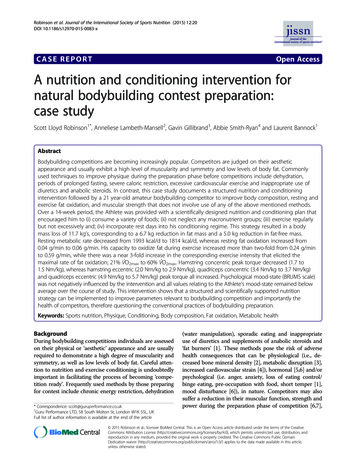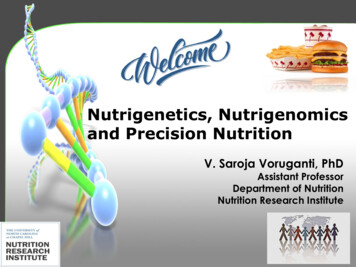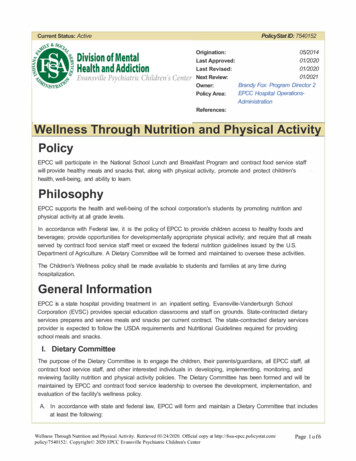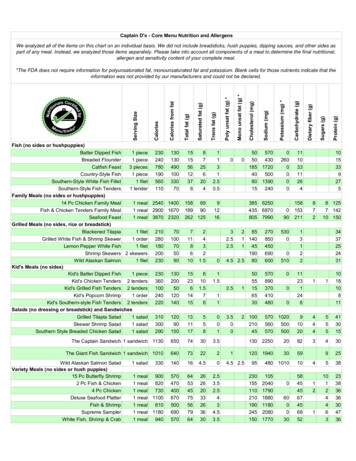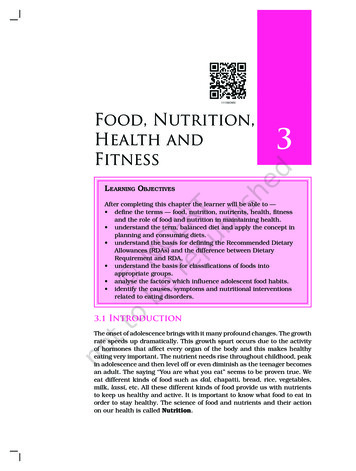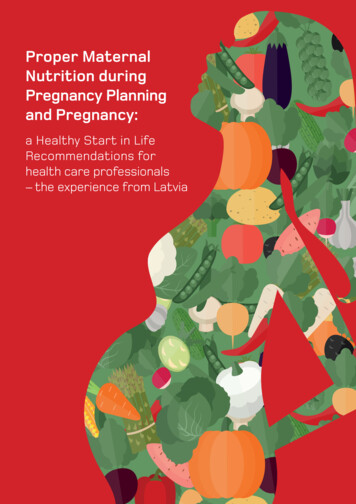
Transcription
Menopause andNutritionPresented by:Pennina Yasharpour, RDN, LDNRegistered DietitianDickinson CollegeKline AnnexEmail: yasharpp@dickinson.edu
What is Menopause? Perimenopause (AKA Pre-Menopause): When a woman transitions from having regular menstrual periods toending menstruation. Can last from 2-10 years, Average age of menopause 51 Menopause: cessation of menses for 12 months when the ovaries stop making estrogen, progesterone andtestosterone Symptoms of Menopause: hot flashes, night sweats, bladderand reproductive changes, insomnia, fatigue, depression,anxiety/irritability and joint pain
Hormonal Imbalance Decreased estrogen increased fat cell production bodies substitute for estrogen deficiency increasedabdominal fat. Decrease progesterone water retention andbloating Not a chronic source of weight gain Decreases over time Decrease in testosterone create lean musclemass gradual loss of muscle slowsmetabolism Increase in Cortisol
Hormone ImbalanceTop Reported Complaints Hot flashes/Night sweats Mood Dysfunction Weight gain Weight resistance Weight gain- abdomen and hips Estrogen deficiency Insulin resistance FatProduction “Spare Tire” Image conflict Libido dysfunction (loss of sex drive)
Weight Gain Weight gain bodies response to menopausal hormonetransition- not just exercise or eating habits Diet Exercise Hormone Balance Abdominal weight gain increased risk for: Breast cancer Heart attack, high blood pressure, elevated cholesterol Type 2 diabetes Alzheimer’s disease Depression. Avoid the “yo-yo” diet no appetite suppressants/diet pills “fad” supplements
Belly Fat Caloric balance Decreased levels of estrogen increases bellyfat even with or without weight gain Subcutaneous fat (pinch and inch) vs.Visceral fat(between the organs) Insulin resistance
How much is too much? Waist measurement: greater than or equalto 35in” unhealthy concentration of belly fatand increased risks. How to check: Place a tape measure around your barestomach, just above your hipbone. Pull the tape measure until it fits snugly aroundyou, but doesn’t push into your skin. Make sure the tape measure is level all theway around. Relax, exhale and measure your waist, resistingthe urge to suck in your stomach.
Regaining Balance1. HormoneReplacementTherapy2. ComplementaryLifestyle Changes Balanced Meals Exercise Sleep Vitamins Hydration Omega 3&6 richfoods
Bio-identical Hormone Therapy(BHRT) BHRT/”natural ” chemically identical to those in the body BHRT includes: Estrogen (2 forms): estradiol, estriol Progesterone Testosterone DHEA Dosing forms Pills, capsules Transdermal (topical, skin; vaginal) Creams, gels, patches Supositories Sublingual (under the tongue) Lozengers, drops
Nutrition Breakfast every day 3 meals with small snacks as needed ( snacks only ifhungry!) Water/hydration Calcium Increased Iron Fiber Increased fruits and vegetables Increase consumption of Omega 3 Avoid the salt shaker Limit alcohol to one or fewer drinks per day Cruciferous vegetables
Carbohydrates Choose complex carbohydrates Vegetables, fruits, nuts/seeds, brown rice, quinoa &yams Limit refined starches & sugars Candy, sugary treats
Protein Protein at breakfast essential for keeping metabolic rate elevated Protein at meals and snacks to assist with insulinresistance & cravings Research shows that eating protein synergistically wexercise is beneficial to building muscle mass.
Cruciferous Vegetables Broccoli, cauliflower, cabbage, kale, bok choi, kohlrabi,Brussels sprouts and mustard, rutabaga and turnipgreens. Rich in Zinc, Vitamins A, B, C, D and E Contains Indole-3-Carbinol (I3C) that is beneficial forestrogen metabolism. Choose at least 1 serving per meal
Healthy Fats Healthy fats at all meals avocado, olive oil, nuts/seeds Avoid Trans-fats, fats solid at room temperature- useinstead olive oil, canola. Help with satiety and avoidance of refined carbstriggering insulin resistance Omega 3 Fats Assist in hormone stabilization Lower inflammation in the body “Feed” the brain
Omega 3 Fats Can not be produced inthe body- must beobtained through the dietor supplements 1.1 g/day for Women, 1.6g/day for Men Reduces inflammation(Arthritis) and lower riskof: Cancer (notably breast) Support brain function andprotect the health ofneurotransmitters in thebrain.
Osteoporosis To Prevent Osteoporosis: Dairy products, orange juice, soy milk & othercalcium fortified foods Kale, Spinach, Tofu, Salmon Vitamin D: Synthesized by the sun, fish, sardines, VitD fortified drinks such as milk, soy milk Weight bearing exercise- helps maintain bone mass Reduce intake of soda (diet too!) Research is linkingsoda intake to decreased bone density.
Hot Flashes Soy (Isoflavones) offer women a source of estrogen, whichmay help relieve hot flashes.Some research shows 40-80 mg (Soy beans, tempeh, tofu) willdecrease symptoms.
Supplements Calcium: 1200mg plus Vit D: 1000IU DailyIron: 8mg per dayMagnesium: 420mg per dayMulti B-Vitamins - 300mg of B6 and 6 mcg of B12 Evening Primrose Oil (EPO) at bedtime can help with loweringincidence of hot flashes (1500-2000 mg.) Rhubarb (Rheum rhaponticum) 4 mg per evening can helpwith alleviating hot flashes (study with 112 women who after28 days reported having 5.5 fewer hot flashes per day thanplacebo group)
Exercise Make sure to include cardio, strength, and stretching For stress: Yoga, meditation For bones: cardio and strength training For your heart: cardio Benefits Prevent osteoporosis Reduces the risk of heart attack and othercardiovascular diseases by increasing heart andrespiratory rates. Keeps joints moving and keeps the muscles around yourjoints strong. This helps in the prevention of arthritis. Maintain regular bowel function, a common problem aspeople become older.
Summary Eat more Omega-3 Fatty Acids. Increase Exercise- Cardio and Weight Bearing exercisesor Yoga. Eat more fruits and vegetables, whole grains, sources ofcalcium Nutrient dense foods- healthy fat foods and complexcarbohydrates. Eat protein prior to exercise to maintain/build musclemass Increase water intake, decrease sugary drinks such assoda.
Questions?
References Dietary weight loss and exercise effects on insulin resistance in postmenopausalwomen. http://www.ncbi.nlm.nih.gov/pubmed/21961463 Interactions of insulin and estrogen in the regulation of cell 225 7509. Menopause and Weight Gain: Hormone Imbalance and the Battle of the Bulge,Joanne Rinker, MS, RD, CDE, LDN Relationship between hormone replacement therapy use with body fat distributionand insulin sensitivity in obese postmenopausal women.http://www.ncbi.nlm.nih.gov/pubmed/11436191 Resistance training in postmenopausal women with and without hormone 6 The Skinny on Peri-menopausal Nutrition, Kristie L. Finnan, RD, LDN Women, Weight and Menopause, Susan B. Dopart, M.S., R.D., C.D.E.
the body- must be obtained through the diet or supplements 1.1 g/day for Women, 1.6 g/day for Men Reduces inflammation (Arthritis) and lower risk of: Cancer (notably breast) Support brain function
